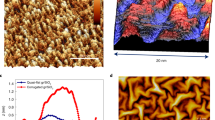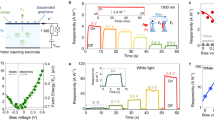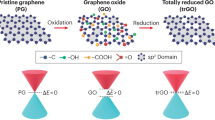Abstract
Optical materials with colour changing abilities have been explored for use in display devices1, smart windows2,3 or in the modulation of visual appearance4,5,6. The efficiency of these materials, however, has strong wavelength dependence, which limits their functionality to a specific spectral range. Here, we report graphene-based electro-optical devices with unprecedented optical tunability covering the entire electromagnetic spectrum from the visible to microwave. We achieve this non-volatile and reversible tunability by electro-intercalation of lithium into graphene layers in an optically accessible device structure. The unique colour changing capability, together with area-selective intercalation, inspires the fabrication of new multispectral devices, including display devices and electro-optical camouflage coating. We anticipate that these results provide realistic approaches for programmable smart optical surfaces with a potential utility in many scientific and engineering fields such as active plasmonics and adaptive thermal management.
This is a preview of subscription content, access via your institution
Access options
Access Nature and 54 other Nature Portfolio journals
Get Nature+, our best-value online-access subscription
$29.99 / 30 days
cancel any time
Subscribe to this journal
Receive 12 print issues and online access
$209.00 per year
only $17.42 per issue
Buy this article
- Purchase on Springer Link
- Instant access to full article PDF
Prices may be subject to local taxes which are calculated during checkout





Similar content being viewed by others
Data availability
Data are available from the authors upon request.
Code availability
The custom code used for fitting of the optical reflectivity is available from the authors upon request.
References
Hosseini, P., Wright, C. D. & Bhaskaran, H. An optoelectronic framework enabled by low-dimensional phase-change films. Nature 511, 206–211 (2014).
Lin, J. et al. Thermochromic halide perovskite solar cells. Nat. Mater. 17, 261–267 (2018).
Montelongo, Y. et al. Electrotunable nanoplasmonic liquid mirror. Nat. Mater. 16, 1127–1135 (2017).
Yu, C. et al. Adaptive optoelectronic camouflage systems with designs inspired by cephalopod skins. Proc. Natl Acad. Sci. USA 111, 12998–13003 (2014).
Salihoglu, O. et al. Graphene-based adaptive thermal camouflage. Nano Lett. 18, 4541–4548 (2018).
Ergoktas, M. S. et al. Graphene-enabled adaptive infrared textiles. Nano Lett. 20, 5346–5352 (2020).
Wuttig, M., Bhaskaran, H. & Taubner, T. Phase-change materials for non-volatile photonic applications. Nat. Photon 11, 465–476 (2017).
Zhang, Y. et al. Broadband transparent optical phase change materials for high-performance nonvolatile photonics. Nat. Commun. 10, 4279 (2019).
Bakan, G., Ayas, S., Saidzoda, T., Celebi, K. & Dana, A. Ultrathin phase-change coatings on metals for electrothermally tunable colors. Appl. Phys. Lett. 109, 071109 (2016).
Granqvist, C. G. et al. Electrochromic materials and devices for energy efficiency and human comfort in buildings: a critical review. Electrochim. Acta 259, 1170–1182 (2018).
Lu, N. et al. Electric-field control of tri-state phase transformation with a selective dual-ion switch. Nature 546, 124–128 (2017).
Llordés, A., Garcia, G., Gazquez, J. & Milliron, D. J. Tunable near-infrared and visible-light transmittance in nanocrystal-in-glass composites. Nature 500, 323–326 (2013).
Runnerstrom, E. L., Llordés, A., Lounis, S. D. & Milliron, D. J. Nanostructured electrochromic smart windows: traditional materials and NIR-selective plasmonic nanocrystals. Chem. Commun. 50, 10555–10572 (2014).
Daukiya, L. et al. Functionalization of 2D materials by intercalation. Prog. Surf. Sci. 94, 1–20 (2019).
Wan, J. et al. Tuning two-dimensional nanomaterials by intercalation: materials, properties and applications. Chem. Soc. Rev. 45, 6742–6765 (2016).
Dresselhaus, M. S. & Dresselhaus, G. Intercalation compounds of graphite. Adv. Phys. 30, 139–326 (1981).
Bao, W. et al. Approaching the limits of transparency and conductivity in graphitic materials through lithium intercalation. Nat. Commun. 5, 4224 (2014).
Pfluger, P., Künzi, H. U. & Güntherodt, H. Discovery of a new reversible electrochromic effect. Appl. Phys. Lett. 35, 771–772 (1979).
Balci, O., Polat, E. O., Kakenov, N. & Kocabas, C. Graphene-enabled electrically switchable radar-absorbing surfaces. Nat. Commun. 6, 6628 (2015).
Kakenov, N. et al. Observation of gate-tunable coherent perfect absorption of terahertz radiation in graphene. ACS Photonics 3, 1531–1535 (2016).
Polat, E. O. et al. Graphene-enabled optoelectronics on paper. ACS Photonics 3, 964–971 (2016).
Xiao, J. et al. Understanding and applying coulombic efficiency in lithium metal batteries. Nat. Energy 5, 561–568 (2020).
Lodico, J. J. et al. Irreversibility at macromolecular scales in the flake graphite of the lithium-ion battery anode. J. Power Sources 436, 226841 (2019).
Brida, D. et al. Ultrafast collinear scattering and carrier multiplication in graphene. Nat. Commun. 4, 1987 (2013).
Piscanec, S., Lazzeri, M., Mauri, F., Ferrari, A. C. & Robertson, J. Kohn anomalies and electron–phonon interactions in graphite. Phys. Rev. Lett. 93, 185503 (2004).
Pisana, S. et al. Breakdown of the adiabatic Born–Oppenheimer approximation in graphene. Nat. Mater. 6, 198–201 (2007).
Das, A. et al. Monitoring dopants by Raman scattering in an electrochemically top-gated graphene transistor. Nat. Nanotechnol. 3, 210–215 (2008).
Sole, C., Drewett, N. E. & Hardwick, L. J. Insitu Raman study of lithium-ion intercalation into microcrystalline graphite. Faraday Discuss. 172, 223–237 (2014).
Zhao, S. Y. F. et al. Controlled electrochemical intercalation of graphene/h-BN van der Waals heterostructures. Nano Lett. 18, 460–466 (2018).
Echeverry, J. P., Chulkov, E. V., Echenique, P. M. & Silkin, V. M. Low-energy collective electronic excitations in LiC6, SrC6 and BaC6. Phys. Rev. B 100, 115137 (2019).
Osiander, R., Firebaugh, S. L., Champion, J. L., Farrar, D. & Darrin, M. A. G. Microelectromechanical devices for satellite thermal control. IEEE Sens. J. 4, 525–531 (2004).
Jansen, A. N., Amine, K. & Henriksen, G. L. Low-cost Flexible Packaging for High-power Li-Ion HEV Batteries Anl-04/09 (Argonne National Laboratory, 2004); https://doi.org/10.2172/828774
Acknowledgements
This research is supported by the European Research Council through an ERC Consolidator Grant (grant no. 682723, SmartGraphene) and an ERC PoC Grant (grant no. 899908, SmartIR). In addition, we acknowledge the Graphene Engineering Innovation Centre (GEIC) for access to the CVD system.
Author information
Authors and Affiliations
Contributions
C.K. conceived the idea. M.S.E. synthesized the graphene samples and fabricated the devices. M.S.E., G.B., E.K., O.S., S.B. and C.K. performed the experiments. L.W.L.F., R.P.F., P.S. and X.Y. helped with the fabrication of the devices. V.I.F., K.N. and R.A.W.D. assisted with data analysis and manuscript preparation. G.B., M.S.E. and C.K. analysed the data and wrote the manuscript with input from all the authors. All authors discussed the results and contributed to the scientific interpretation as well as to the writing of the manuscript. VIF and KSN acknowledge support from EU Flagship Programs (Graphene CNECTICT-604391 and 2D-SIPC Quantum Technology), European Research Council Synergy Grant Hetero2D, the Royal Society, EPSRC grants EP/N010345/1, EP/P026850/1, EP/S030719/1.
Corresponding author
Ethics declarations
Competing interests
C.K. is involved in activities towards the commercialization of graphene-based optical surfaces by SmartIR Ltd. The work is subject to a patent application by C.K., M.S.E. and G.B. The remaining authors declare no competing interests.
Additional information
Peer review information Nature Photonics thanks the anonymous reviewers for their contribution to the peer review of this work.
Publisher’s note Springer Nature remains neutral with regard to jurisdictional claims in published maps and institutional affiliations.
Supplementary information
Supplementary Information
Supplementary Figs. 1–31, notes 1–8, Tables 1–3 and references 1–32.
Supplementary Video 1
Visible colour change of the device during charging and discharging cycles. The device was discharged through an LED load.
Supplementary Video 2
(i) Modulation of both the visible and infrared properties. The voltage was measured as 3.82 V when fully charged. (ii,iii) Independent modulation of the infrared and visible reflection. For the infrared modulation only, the voltage was kept less than 3.6 V. In all cases, the device was charged with 4 mA and discharged with −4 mA.
Supplementary Video 3
Video showing adaptation of the infrared appearance to a (i) cold and (ii) hot background.
Rights and permissions
About this article
Cite this article
Ergoktas, M.S., Bakan, G., Kovalska, E. et al. Multispectral graphene-based electro-optical surfaces with reversible tunability from visible to microwave wavelengths. Nat. Photon. 15, 493–498 (2021). https://doi.org/10.1038/s41566-021-00791-1
Received:
Accepted:
Published:
Issue Date:
DOI: https://doi.org/10.1038/s41566-021-00791-1
This article is cited by
-
Tunable VO2 cavity enables multispectral manipulation from visible to microwave frequencies
Light: Science & Applications (2024)
-
Large second-order susceptibility from a quantized indium tin oxide monolayer
Nature Nanotechnology (2024)
-
Whole-infrared-band camouflage with dual-band radiative heat dissipation
Light: Science & Applications (2023)
-
Transparent dynamic infrared emissivity regulators
Nature Communications (2023)
-
Electrochemically modulated interaction of MXenes with microwaves
Nature Nanotechnology (2023)



